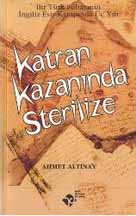CLAIM 1
From the book “Katran KazanInda Sterilize” (“Sterilized in Tar
Cauldron”) by Imge Publications, written by Ahmet Duru who revealed
the diary of the sub-lieutenant Ahmet Altinay from Karaman…
“In WWI, 150 thousand of our soldiers were captured by the British.
And some of these soldiers were imprisoned in Seydibesir Useray-i
Harbiye Camp near the city of Alexandria in Egypt. The full name of
the camp was “Seydibesir Kuveysna Osmanli Useray-i Harbiye (4) Kampi”.
In this camp, the Ottoman soldiers of 16th Division’s 48th Regiment
who were captured at the Palestine fronts in 1918 were interned. For
two years until June 12th, 1920, they were subjected to any kind of
torture, oppression, heavy insults and humiliation.
The reason for this inhumane treatment was the Armenians. The war was
over. Nevertheless, to release the soldiers besides the ones who died
because of heavy conditions in the camp was not to the benefit of the
British. Because the British were brainwashed by Armenians, being told
that in a potential new war they could come up against these soldiers
again. The solution was massacre…
Our soldiers, forced by bayonets, were put in disinfection pools with
the excuse of wiping out germs. But the chemical, krizol, was added a
lot more than normal in the water. Even just when they put their feet,
our soldiers got scalded. However, the British troops didn’t let them
get out of the pool by threatening with rifles.
Our soldiers didn’t want to put their heads under the water that
reached waist level. But then the British started shooting in the air.
Our soldiers knelt and put their heads under water not to die.
But the ones who got their heads out of the water couldn’t see any
more. Because the eyes were burned…The resistance of our soldiers who
saw what happened to the ones that got out was no use and our 15
thousand men got blinded.
This savagery was discussed in May 25th, 1921, in the Turkish Great
National Assembly. The congressmen Mr. Faik and Mr. Seref proposed
that 15 thousand sons of this country were blinded in Egypt by being
put in the “krizol” pool; and wanted the Assembly to make an attempt
for punishment of the British physicians, commanders and soldiers who
were guilty of this act.
Of course the newly founded government had a thousand other problems.
Demanding an explanation for this act was easily forgotten.
The British commanders of the camp, because of the wrong, mendacious
translations and provocations of Armenian translators who knew
Turkish, had become fierce Turk enemies.
COUNTER CLAIM
The British run PoW camps in Egypt were regularly inspected by the
diplomatic representatives of neutral countries and by the
International Committee of the Red Cross
Sidi Bishr Camp (Seydibesir Useray-i Harbiye Camp) was visited on 6th
January 1917 and the report on that visit can be read in chapter 7,
here
Bryn
CLAIM 2
The other claim made by Yücel Yanıkdağ in his unpublished PhD thesis
Ill-fated Sons of the Nation: Ottoman Prisoners of War in Russia and
Egypt, 1914-1922 makes the claim that the British authorities
deliberately infected Turkish POWs with Pellagra. This particular
story is also doing the rounds of the “British plot to kill Turks
inspired by Armenian” circuit and has equal credibility.
COUNTER CLAIM
The nub of the Pellagra claim is that the British deliberately singled
out the Turks for ill treatment by inadequate diet leading to the
ex-POWs having the highest death rate from Pellagra amongst all the
other prisoners. On the basis of the death rate, it was concluded that
Pellagra was a deliberate policy. That Turkish POWs died in great
numbers from Pellagra is well documented in British sources. However,
this churlish complaint does not mention that Pellagra takes 5-6 years
to manifest itself into a fatal condition. No Turkish POW spent that
long in their incarceration leading to the conclusion that these men
suffered from Pellagra prior to becoming a POW. It wasn’t until the
mid 1920’s that it was discovered that Pellagra was due to dietary
problems.
CLAIM 3
Cholera at Berramke Barracks in Damascus was deliberate to kill Turks.
COUNTER CLAIM
A search of the Australian archives – every single available file
relating to POWs is very much available and they provide information
with the good and the bad. Nothing is covered up. The worst case
regarded the 12,000 Ottoman soldiers who surrendered at the Berramke
Barracks in Damascus after its fall on 1 October 1918. These men were
deserted by their own support teams and left to fend for themselves
without any resources with neither food nor medicines. After a few
days being held as POWs, cholera broke out amongst this group. Over a
two week period many hundreds of men died through cholera, the worst
day recording over 150 deaths. By dint of hard work, the POWs were put
to work to provide a satisfactory sanitation and drinking water
system. Some men had to be coerced into working towards the common
good. The result – cholera was brought under control. The deaths from
cholera did not only effect the Turks but also the Australian, Indian,
French and British soldiers in the area with many of these troops also
dying.
So the cholera outbreak at Damascus was not a sinister British plot to
kill Turks, it was a problem brought on by the neglect of the Turkish
command for the health of their soldiers and citizens in Damascus. The
ordinary soldier in both the Allied forces and the Turkish army paid a
high price for this neglect.


Leave a Reply